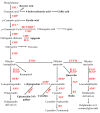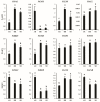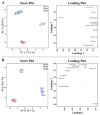Expression Analysis of Phenylpropanoid Pathway Genes and Metabolomic Analysis of Phenylpropanoid Compounds in Adventitious, Hairy, and Seedling Roots of Tartary Buckwheat
- PMID: 35009093
- PMCID: PMC8747410
- DOI: 10.3390/plants11010090
Expression Analysis of Phenylpropanoid Pathway Genes and Metabolomic Analysis of Phenylpropanoid Compounds in Adventitious, Hairy, and Seedling Roots of Tartary Buckwheat
Abstract
Tartary buckwheat (Fagopyrum tataricum) is an important crop that belongs to the Polygonaceae family, whose roots have received considerable attention due to the presence of compounds with high nutritional and medicinal value. In this study, we aimed to develop an efficient protocol for the culture of adventitious (ARs) and hairy (HRs) roots on a half-strength Schenk and Hildebrandt (SH) medium containing different concentrations of the auxins, α-naphthaleneacetic acid (NAA), indole-3-butyric acid (IBA), and indole-3-acetic acid (IAA). The highest percentage of root induction (91.67%) was achieved with 0.5 mg/L IAA, whereas the greatest number of roots was found in 1 mg/L IAA. In contrast, 0.1 mg/L IBA returned the longest roots. As expected, HRs were obtained from in vitro leaf explants infected with Agrobacterium rhizogenes R1000. Quantitative real-time polymerase chain reaction (qRT-PCR) analysis of 11 phenolic pathway genes revealed that five genes (FtPAL, FtC3H, FtHQT, FtCHS, and FtANS) were highly expressed in HRs, whereas only four (FtC4H, FtFLS2, FtDFR, and FtANR), and three (Ft4CL, FtCHI, and FtF3H) were recognized in the ARs and seedling roots (SRs), respectively. HPLC analysis of phenolic compounds in different root cultures showed that the majority of the phenolic compounds (both individual and total) were significantly accumulated in the HRs. Principal component analysis (PCA) identified differences among the three root types, whereby HRs were separated from ARs and SRs based on the amount of phenolic compounds present. Analysis of the metabolic pathway revealed that among the identified metabolites, the 3, 2, and 1 pathways were associated with flavonoid, flavone and flavonol, and phenylpropanoid biosynthesis, respectively. Hierarchical clustering analysis and the heat map showed that the different root cultures presented unique metabolites.
Keywords: Agrobacterium rhizogenes; Fagopyrum tataricum; auxins; buckwheat; phenolic compounds; root culture.
Conflict of interest statement
The authors declare no conflict of interest.
Figures







Similar articles
-
Effect of Different Agrobacterium rhizogenes Strains on Hairy Root Induction and Phenylpropanoid Biosynthesis in Tartary Buckwheat (Fagopyrum tataricum Gaertn).Front Microbiol. 2016 Mar 14;7:318. doi: 10.3389/fmicb.2016.00318. eCollection 2016. Front Microbiol. 2016. PMID: 27014239 Free PMC article.
-
Metabolomic analysis and phenylpropanoid biosynthesis in hairy root culture of tartary buckwheat cultivars.PLoS One. 2013 Jun 14;8(6):e65349. doi: 10.1371/journal.pone.0065349. Print 2013. PLoS One. 2013. PMID: 23799007 Free PMC article.
-
Accumulation of phenylpropanoids and correlated gene expression in hairy roots of tartary buckwheat under light and dark conditions.Appl Biochem Biotechnol. 2014 Dec;174(7):2537-47. doi: 10.1007/s12010-014-1203-9. Epub 2014 Sep 7. Appl Biochem Biotechnol. 2014. PMID: 25194705
-
Efficient Rutin and Quercetin Biosynthesis through Flavonoids-Related Gene Expression in Fagopyrum tataricum Gaertn. Hairy Root Cultures with UV-B Irradiation.Front Plant Sci. 2016 Feb 4;7:63. doi: 10.3389/fpls.2016.00063. eCollection 2016. Front Plant Sci. 2016. PMID: 26870075 Free PMC article.
-
Deep sequencing of the transcriptome reveals distinct flavonoid metabolism features of black tartary buckwheat (Fagopyrum tataricum Garetn.).Prog Biophys Mol Biol. 2017 Mar;124:49-60. doi: 10.1016/j.pbiomolbio.2016.11.003. Epub 2016 Nov 9. Prog Biophys Mol Biol. 2017. PMID: 27836511 Review.
Cited by
-
Comparative Analysis of Primary and Secondary Metabolites in Different In Vitro Tissues of Narcissus tazetta var. chinensis.ACS Omega. 2024 May 23;9(22):23761-23771. doi: 10.1021/acsomega.4c01735. eCollection 2024 Jun 4. ACS Omega. 2024. PMID: 38854557 Free PMC article.
-
Changes in Phenolic Compounds and Antioxidant Activity during Development of 'Qiangcuili' and 'Cuihongli' Fruit.Foods. 2022 Oct 13;11(20):3198. doi: 10.3390/foods11203198. Foods. 2022. PMID: 37430947 Free PMC article.
-
Comparative transcriptomic and hormonal analyses reveal potential regulation networks of adventitious root formation in Metasequoia glyptostroboides Hu et Cheng.BMC Genomics. 2024 Nov 18;25(1):1098. doi: 10.1186/s12864-024-10989-6. BMC Genomics. 2024. PMID: 39558286 Free PMC article.
-
Environmental and Genetic Factors Involved in Plant Protection-Associated Secondary Metabolite Biosynthesis Pathways.Front Plant Sci. 2022 Apr 8;13:877304. doi: 10.3389/fpls.2022.877304. eCollection 2022. Front Plant Sci. 2022. PMID: 35463424 Free PMC article. Review.
-
Hairy Root Cultures as a Source of Polyphenolic Antioxidants: Flavonoids, Stilbenoids and Hydrolyzable Tannins.Plants (Basel). 2022 Jul 27;11(15):1950. doi: 10.3390/plants11151950. Plants (Basel). 2022. PMID: 35956428 Free PMC article. Review.
References
-
- Guillon S., Trémouillaux-Guiller J., Pati P.K., Gantet P. Hairy roots: A powerful tool for plant biotechnological advances. In: Ramawat K.G., Merillon J.M., editors. Bioactive Molecules and Medicinal Plants. Springer; Berlin/Heidelberg, Germany: 2008. pp. 271–283.
-
- Bhatia S., Bera T., Dahiya R., Bera T., Bhatia S., Bera T. Classical and nonclassical techniques for secondary metabolite production in plant cell culture. In: Bhatia S., Sharma K., Dahiya R., Bera T., editors. Modern Applications of Plant Biotechnology in Pharmaceutical Sciences. Elsevier; Amsterdam, The Netherlands: 2015. pp. 231–291.
LinkOut - more resources
Full Text Sources
Research Materials

